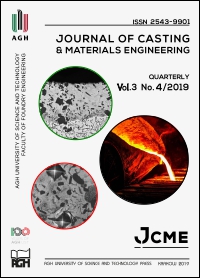Characteristics of Wastes Produced by Polish Ferrous Alloys Casting Foundries between the Years 2010–2014
DOI:
https://doi.org/10.7494/jcme.2019.3.4.71Abstract
The balance of wastes originating from the foundry processes of ferrous alloys, prepared on the basis of data made available by the Polish Central Statistical Office, is presented in this paper. The kind and amount of individual foundry wastes subjected to management and storage by foundry plants were analysed. The problem of wastes between the years 2010–2016 is discussed on the national scale, as well as in individual regions or voivodeships. Altogether, 27,375.9 tons of waste from the group no. 10, of which non-ferrous metal and ferrous alloy wastes from foundry plants constituted 2%, were produced in Poland in 2010. This situation remained at a similar level over successive years, till 2014. The positive prognosis constitutes the fact that the amount of waste stored on dumping grounds belonging to foundry plants in Poland is gradually decreasing. This may be related to increasing costs of waste storage. During the tested years, the annual amount of gathered waste decreased from 4,796.6 thousand tons (in 2010) to 4,477.6 thousand tons (in 2014).Downloads
References
Holtzer, M., Dańko, R., Dańko, J., Kubecki, M., Bobrowski, A., & Śpiewok, W. (2013). Ocena szkodliwości materiałów wiążących stosowanych do mas formierskich i rdzeniowych nowej generacji. Kraków: Wydawnictwo Naukowe Akapit. (in Polish)
Meléndez, A., García, E., Carnicer, P., Pena, E., & Larrión, M. (2012). Fine and Ultrafine Emission Dynamics from a Ferrous Foundry Cupola Furnace. Journal of the Air & Waste Management Association. 60(5), 556–567. doi:10.3155/1047-3289.60.5.556
Maj, M., Werrtz, J., & Piekło, J. (2017). Environmental Protection Versus Foundry Engineering Practice. Archives of Foundry Engineering. 17(2), 202–206. Retrieved from http://www.afe.polsl.pl/index.php/pl/4588/environmental-protection-versus-foundry-engineering-practice.pdf
Dutouquet, C., Gallou, G., Le Bihan, O., Sirven, J.B., Dermigny, A., Torralba, B., & Frejafon, E. (2014). Monitoring of heavy metal particle emission in the exhaust duct of a foundry using LIBS. Talanta. 127, 75–81. doi:10.1016/j.talanta.2014.03.063
LaFay V., Neltner S., Carroll D., & Couture D.J. (2010). Know the Environmental Impact of Your Additives. Modern Casting. 10, 27–29.
Kubecki, M. (2015). Oznaczanie wybranych niebezpiecznych zanieczyszczeń powietrza, generowanych w procesie termicznego rozkładu mas formierskich z żywicami furanowymi. Polska Akademia Nauk, Oddział Katowice, Komisja Odlewnictwa. Retrieved from https://docplayer.pl/67397149-Oznaczanie-wybranych-niebezpiecznych-zanieczyszczen-powietrza-generowanych-w-procesie-termicznego-rozkladu-mas-formierskich-z-zywicami-furanowymi.html. (in Polish)
Ribeiro, M.G., & Filho, W.R.P. (2006). Risk assessment of chemicals in foundries: The International Chemical Toolkit pilot-project. Journal of Hazardous Materials. 136(3), 432–437. doi:10.1016/J.JHAZMAT.2006.01.019
Faber, J., & Perszewska, K. (2017). Identification Odor Compounds Emitted During the Heating of Molding Sands. Archives of Foundry Engineering. 17(2), 178–182. doi:10.1515/afe-2017-0071
Kubecki, M., Holtzer, M., Bobrowski, A., Dańko, R., Grabowska, B., & Żymankowska-Kumon, S. (2018). Analysis of the Compounds from the BTEX Group, Emitted During Thermal Decomposition of Alkyd Resin. Archives of Foundry Engineering. 12(3), 69–74. doi:10.2478/v10266-012-0084-z
Moryson, G. (2009). Evaluation classification in the wastes of aluminum and its alloys. Archives of Mechanical Technology and Automation. 29(3), 59–72.
Holtzer, M., Dańko, R., & Żymankowska-Kumon, S. (2012). Foundry Industry – Current State and Future Development in the World ’ S Casting Production. Metalurgija. 51(3), 337–340.
Dańko, J., Dańko, R., & Holtzer, M. (2003). Reclamation of used sands in foundry production. Metalurgija. 42(3), 173–177.
Pezarski, F., Maniowski, Z., & Izdebska-szanda, I. (2004). The practical aspects of the sand reclamation process from the waste foundry sands. Archiwum Odlewnictwa. 4(13), 171–176. (In Polish)
Łucarz, M. (2015). Thermal reclamation of the used moulding sands. Metalurgija. 54(1), 109–112.
Dańko, R. (2012). Investigations of the matrix quality in the circulation process of moulding sands with an organic binder. Archives of Foundry Engineering. 12(1), 21–26.
Skrzyński, M., & Dańko, R. (2014). Assessment of the Destruction Degree of the Quartz Matrix in the REGMAS Reclaimer. Archives of Foundry Engineering. 14(1), 17–22.
Holtzer, M., Dańko, R., Żymankowska-Kumon, S., & Kamińska, J. (2009). Assessment of the possibility of utilisation of used ceramic moulds originated from the investment casting technology. Archives of Foundry Engineering. 9(2), 159–164.
Joseph, M.K., Banganayi, F., & Oyombo, D. (2017). Moulding Sand Recycling and Reuse in Small Foundries. Procedia Manufacturing. 7, 86–91. doi:10.1016/J.PROMFG.2016.12.022
Dańko, J., Kamińska, J., & Skrzyński, M. (2013). Reclamation of spent moulding sands with inorganic binders in the vibratory reclaimer REGMAS. Archives of Metallurgy and Materials. 58(3), 993–996. doi:10.2478/amm-2013-0117
Kamińska, J. (2013). Analiza wpływu parametrów pracy granulatora misowego na przebieg procesu granul owania pyłów poregeneracyjnych. Wydział Odlewnictwa, Kraków. (in Polish)
Waste (excluding municipal waste) by Waste Classification. (n.d.). Statistics Poland. Retrieved from http://swaid.stat.gov.pl/StanOchronaSrodowiska_dashboards/Raporty_predefiniowane/RAP_DBD_SROD_6.aspx (in Polish)
46th Census of World Casting Production. (2012). Modern Casting. 25–29.
47th Census of World Casting Production. (2013). Modern Casting. 18–23.
45th Census of World Casting Production. (2011). Modern Casting. 16–21.
48th Census of World Casting Production. (2014). Modern Casting. 17–21.
49th Census of World Casting Production. (2015). Modern Casting. 26–31.
50th Census of World Casting Production. (2016). Modern Casting. 25–29.
Census of World Casting Production: Global Casting Production Growth Stalls. (2017). Modern Casting. 24–29.
Downloads
Published
Issue
Section
How to Cite
Accepted 2020-01-15
Published 2020-01-31


